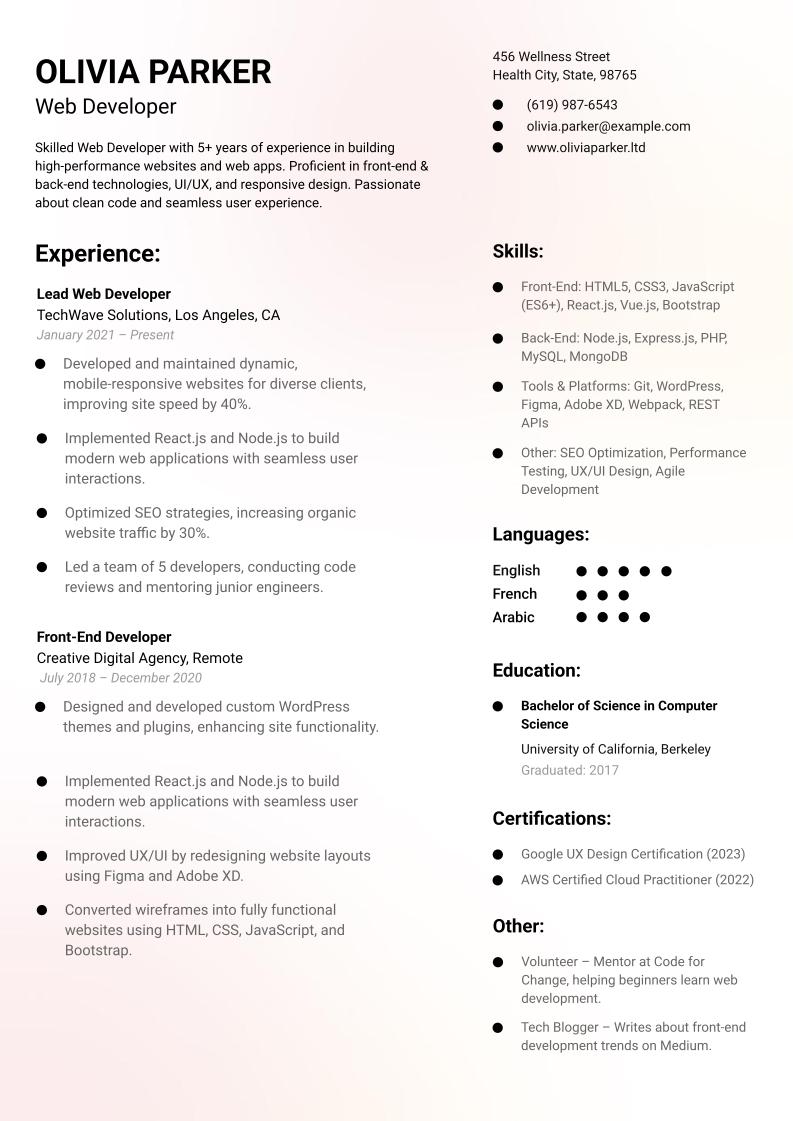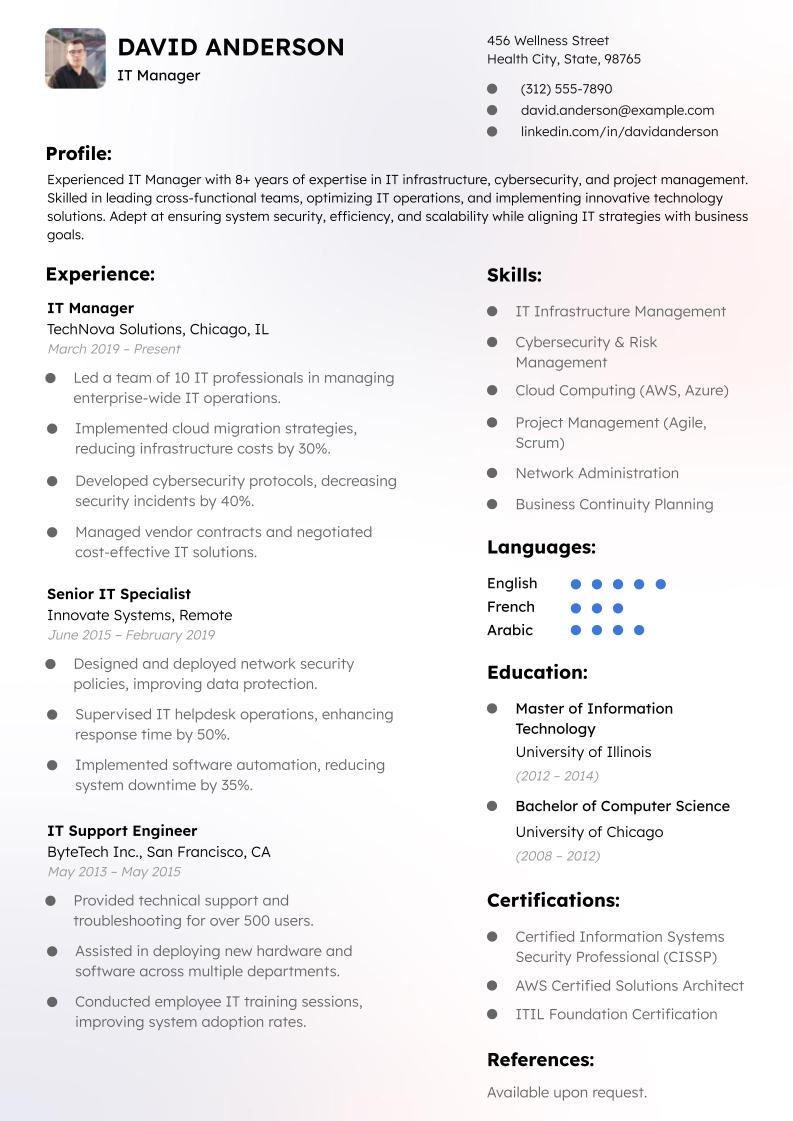In the constantly evolving world of Information Technology, an IT resume that clearly communicates your strengths can open the door to fulfilling opportunities. Whether you specialize in network administration, helpdesk support, cloud computing, cybersecurity, or a combination of these domains, your resume should highlight both your technical proficiency and your ability to work within diverse teams. In this article, we’ll discuss the core components of a strong IT resume, share best practices for adapting to different IT roles, and show how Rezoom can help you stand out in today’s competitive job market.

Web Developer resume Examples & Templates
Kick-start your tech journey with a powerful Web Developer resume that emphasizes coding proficiency, collaborative mindset, and proven achievements. Rely on Rezoom to simplify the entire process….
Why an Effective IT Resume Matters
IT professionals are in high demand, yet competition for the best roles can be intense. A well-structured IT resume:
- Demonstrates Technical Knowledge: Potential employers want proof that you can handle the hardware, software, and network challenges typical in modern organizations.
- Highlights Problem-Solving Abilities: Your track record of diagnosing and fixing issues is key to succeeding in IT roles.
- Reflects Professionalism: A clear layout, concise sections, and relevant keywords help your resume pass both human and Applicant Tracking System (ATS) reviews.
- Showcases Adaptability: The IT landscape changes quickly, so employers look for professionals who can learn and implement emerging technologies.
Core Sections for a High-Impact IT Resume
A robust IT resume usually includes the following sections to demonstrate your breadth of expertise and achievements:
- Contact Information
- Full Name
- Professional Email Address
- Phone Number
- LinkedIn (optional but often beneficial)
- Personal Website or GitHub (if relevant to demonstrate technical projects)
- Professional Summary
- Provide a concise overview of your IT background, including years of experience.
- Mention notable accomplishments, such as system upgrades, cloud migrations, or security enhancements.
- Key Skills & Technical Proficiencies
- Operating Systems: Windows, Linux, macOS.
- Networking: Routers, switches, firewalls, VPN management.
- Tools & Platforms: Virtualization (VMware, Hyper-V), Cloud (AWS, Azure), DevOps (Jenkins, Docker).
- Security: Vulnerability scanning, incident response, data encryption.
- Methodologies: Agile, ITIL, Scrum.
- Work Experience
- Most Recent Role: Emphasize scope of responsibility, key projects, and quantifiable outcomes (e.g., “Reduced server downtime by 25% through proactive monitoring.”).
- Previous Positions: Highlight relevant technical tasks, team collaborations, and any leadership roles.
- Freelance or Contract Work: Focus on diverse projects, if applicable, to demonstrate adaptability.
- Education
- List degrees, certifications, or specialized training relevant to your IT focus.
- Include course highlights if they’re directly related to roles you’re pursuing (e.g., cybersecurity, database management, cloud computing).
- Certifications & Additional Achievements
- Popular Certifications: CompTIA (A+, Network+, Security+), Microsoft (MCP, MCSA), Cisco (CCNA, CCNP), AWS (Cloud Practitioner, Solutions Architect).
- Achievements: Industry awards or professional recognitions that reflect your expertise.
- Optional Sections
- Community Involvement: Tech meetups, hackathons, or open-source contributions.
- Languages: Any additional languages can benefit multinational companies or global IT teams.
Learn more about evolving tech job market trends at the U.S. Bureau of Labor Statistics
Varied IT Specialties and Resume Adaptations
Information Technology covers a wide array of specialties. Consequently, your IT resume should reflect the specific demands of your niche:
- Systems Administrator: Stress server management, virtualization, and scripting (PowerShell, Bash).
- Network Engineer: Highlight network design, security implementations, and troubleshooting.
- Help Desk / Technical Support: Emphasize customer service, ticketing systems (like ServiceNow), and troubleshooting speed.
- Cybersecurity Analyst: Focus on threat detection, penetration testing, and compliance (HIPAA, PCI-DSS).
- Cloud Specialist: Detail deployments on AWS, Azure, or GCP, plus cost-optimization strategies.
Tailoring your resume to the exact role ensures recruiters see a clear match between your background and their job requirements.
Tweak the bold elements to align with your expertise and achievements.
For dynamic and impactful verbs to describe your achievements, check out our internal resource on 500 Powerful ActionVerbs.

Action Verbs: 500 Powerful Words to Supercharge Your Resume
When crafting a resume, every word matters. Action verbs play a crucial role in capturing attention and showcasing your achievements effectively. Instead of listing mundane responsibilities, dynamic…
Showcasing Soft Skills in an IT Resume
Although technical skills dominate many IT roles, don’t overlook the importance of soft skills:
- Communication: You may often interface with non-technical staff or guide end-users.
- Problem-Solving: Quick thinking in high-pressure scenarios ensures minimal service disruption.
- Collaboration: IT requires synergy across multiple teams, from developers to project managers.
- Adaptability: Staying abreast of new technologies and responding swiftly to changing requirements are critical qualities.
Using Rezoom to Simplify Your Application
Developing a standout IT resume can be time-consuming. Luckily, Rezoom helps streamline the process:
- Customizable Templates: Professional layouts catered to IT roles.
- Pre-Written Bullet Points: Tailored suggestions for tasks like system monitoring, security patches, or network configuration.
- Real-Time Feedback: Optimize your resume for ATS and ensure high readability for recruiters.
- One-Click Editing: Adapt your resume for specific job listings without starting from scratch.
Final Checks: Polishing Your IT Resume
- Length & Layout: One page suffices for most junior to mid-level candidates; experienced professionals may need two pages.
- Grammar & Spelling: Simple mistakes can tarnish your meticulous IT brand.
- Consistency: Align all headings, bullet points, and spacing for a sleek design.
Conclusion
A compelling IT resume merges robust technical skills, proven achievements, and a glimpse of your collaborative personality. By quantifying outcomes (e.g., “Reduced ticket resolution times by 30%”) and emphasizing adaptability in a rapidly changing field, you’ll leave a lasting impression on potential employers.
Finally, tools like Rezoom can simplify your resume-building journey, offering specialized templates and real-time insights that help you shine. Presenting a balanced blend of specialized knowledge, teamwork, and problem-solving on your IT resume can significantly boost your chances of securing interviews and propelling your career forward. Good luck!
Rate this article
7 people rated this article

Comments